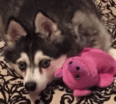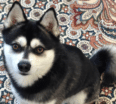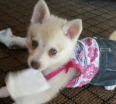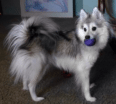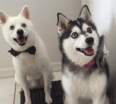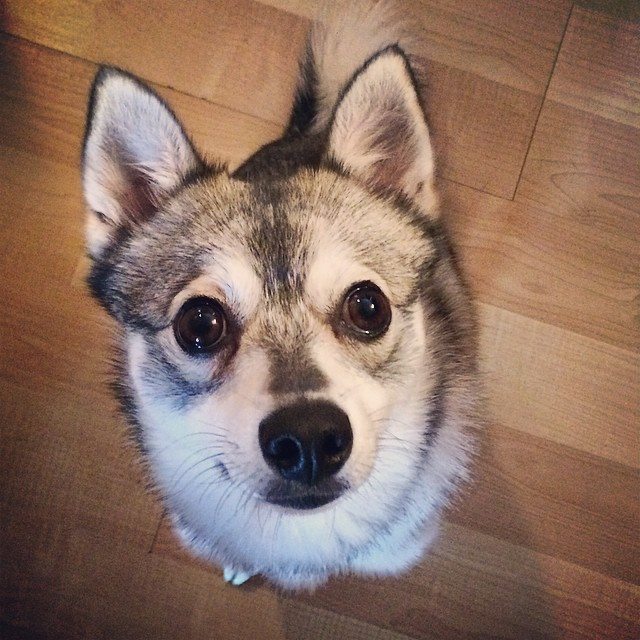The Truth About the Teacup Husky
The Truth About Tea Cup Dogs
What is a teacup size in reference to dogs? Is it really possible to achieve safely? This unofficial term refers to miniature-sized dogs. Despite their popularity among the fashion industry community, teacup dogs are primarily bred for novelty as opposed to health. People seek these dogs to be able to carry them in their bags, and although that might be undeniably adorable, it comes at price.
The Alaskan Klee Kai and Siberian Huskies
Some breeds are just incapable of achieving this size no matter how hard breeders try. The teacup husky is one of the most popular dog types in the world, but the fact of the matter is, this type of dog does not exist. Breeders use various unethical tricks to sell teacup husky puppies. The most common is to sell the similar Alaskan Klee Kai.
This breed looks very similar to a supposed teacup version of a Siberian husky. There are only subtle differences in their appearance, such as lighter shades of gray and more white in their coat. To the untrained eye, their appearance is identical. The true differences lie in their personality and behavior.
The fact is, the Alaskan Klee Kai has very little relation to the Siberian husky, and its temperament is the clearest evidence of that fact. Huskies are welcoming and adventurous. They love meeting new people and greet anyone in sight. Although mostly bred in the upper part of North America to drive sleds, and so very isolated from large communities, they still love people. When they meet new people, they are excited as opposed to afraid.
They are so friendly that they make horrible watchdogs. If a trespasser were to attempt to steal from you with a husky on guard, the dog would not only refuse to stop the intruder, but assist them in carrying the stolen good to their hideout. This is a stark contrast to the Alaskan Klee Kai, which is naturally more reserved, shy, and fearful of strangers. Owners of these breeds are required to make active socialization efforts to improve their attitude towards strangers.
This disparity has led many uninformed owners of Alaskan Klee Kais to grief and dissatisfaction. This is one example on how the demand for teacup dogs and teacup dog breeds lead to unethical breeding and salesman tactics.
Teacup Dogs
No major or reputable dog registry acknowledges the validity of the teacup breed, thus it cannot be accurately associated with a toy dog. The average weight for a toy dog ranges from 4 to 7 pounds. Anything lighter than that may classify the dog as a runt of the litter. No official size constitutes a teacup breed, but the unofficial definition of a teacup dog is one that is 17 inches or fewer and weighs 4 pounds or fewer at 12 months.
Popular breeds for creating teacup dogs are Silky Terriers, Pomeranians, Maltese, Pugs, Poodles, Yorkshire Terriers, Chihuahuas, and Shih Tzus among other types. Obviously, these breeds are naturally smaller and lend themselves more easily to achieving that exceedingly small stature. Most recognized and responsible breeders do not breed anything lighter than four pounds, so teacup dogs cannot be found in their litters.
Health Defects in Teacup Dog Breeds
Due to their incredibly small weight, these dogs only have a life span of about 12 to 15 years. They are bred to an unnaturally small size, which leaves them vulnerable to serious health conditions.
It takes tremendous amounts of energy for dogs to breathe and for their hearts to pump blood. The smaller they are, the fewer resources they have to perform these functions. The most common issue that these dogs experience is hypoglycemia, which is defined by chronic low blood sugar. This very serious ailment can lead to seizures and death when not professionally monitored. When your dog has this disease, they need fed multiple meals daily to keep their blood sugar up. Even though you feed them constantly, they fail to grow.
Teacup puppies also regularly have problems urinating due to their exceedingly small bladder sizes. This is very common when there is a lacking of genetic health testing from responsible veterinarians.
Teacup Dog Breeders and the Market
The reason breeders are able to make these dogs available on the market and turn a profit despite the common risks is high demand. Teacup dogs are always fashionable, an extremely popular resource in fashion and pop culture. That means there is lots money to be made from these animals.
This is why these breeders are able to charge an extremely large price for these puppies. Price determines value as well, so the higher the charge, the higher the competition and demand, and the higher the demand, the more breeders make teacup dogs, and the cycle continues and continues. Many unethical breeders use methods devastatingly harmful to the health of the dogs involved. Teacup dogs are made by mating two uniquely tiny dogs of the same breed.
Because the mother dog is already so small, there are often birthing complications that put the mother and puppies at risk. The deplorable breeders purposely encourage stunted growth through starvation and under-nutrition. Since the teacup breed is not an officially defined type, it is very easy for breeders to provide disinformation to inexperienced buyers.
Breeders commonly advertise a regular dog as a teacup by simply lying about the puppy’s age. It is also common for breeders to take the runts of the litter and pass them off as teacup dogs, and the client is left with a pet that will refuse grow and most likely die early.
Teacup as a Buzzword
The term “teacup” has become a term for breeders to target Internet shoppers. Scammers take advantage that this keyword is vague and unofficial. Any small-sized dog can be marketed as a teacup dog and consumers will flock to it. The lack of definition from any professional board has made large gray areas where the likelihood of getting a sick or unhealthy dog is extremely likely.
The common notion when it comes to animals is the smaller, the cuter. The teacup term completely embodies that philosophy. It describes the appearance of these animals in a lighthearted and somewhat unspecific manner. Without properly describing the honesty of these animals—that they are below a healthy weight—it is easy for consumers to assume that there are no risks or conditions with these animals. Only those who take the time to research the animals thoroughly will be aware of the reality.
The Internet has embraced the teacup notion fully with pictures and illustrations of exceedingly small animal and pets, both imaginary and real. It very well might be unintentional by the providers of this type of content, but the prevalence of these pictures supports the idea that there is nothing wrong with exceptionally small animals. Scammers know that if that information were obvious, their sales would plummet.
There are limits to the capabilities of the species. It is the responsibility of every potential pet owner to keep his or her own desires within those parameters. The quickest and most effective way to put unethical breeders out of business is to stop purchasing their animals.
How You Should Purchase a Small Dog
If you are considering buying or adopting an adult or pup classified as a “teacup,” put in the effort to get a certificate of good health from an expert vet before conducting the transaction. A reputable breeder will provide you a contract that includes a health guarantee. This agreement should require you to have the puppy inspected by a veterinarian of your choosing immediately after purchase.
If your breeder does not offer this contract when you are going to buy a puppy, chances are they are not a responsible source. Even the most expert breeders will end up with a smaller-than-average pup, but this is unintentional. The proper course of action on their part during this is to insist the buyer to spay or neuter their pet beforehand to ensure the quality of the breed.
In order to find a trustworthy breeder, ask your local breed clubs or vet for references. If possible, make a no-notice visit to the breeder. Without time to dress up their operation, you will be able to determine whether the dogs are clean, happy, and raised in humane conditions. Attempt to view the puppy’s parents and ask about the puppy’s behavior characteristics and meal preferences.
Even though it is common for breeders and pet owners to classify temperament, attitudes, meal habits, and other traits to specific breeds, every individual dog has their own unique personality and preferences. It is very possible to get a quiet Chihuahua, or an aggressive Siberian husky.
That is why consultations with the breeder of your new pet are necessary. Keep in mind that dogs also mimic the behavior and moods of their owner, so beware of aggressive breeders, and make sure your emotional state is under control in the presence of your dog.
As with anything relating to pets and pet care, the best defense against being taken advantage of is quality information. Do your part as a responsible dog owner and properly research the honest practices and reputable breeders. The dog owner community is incredibly supportive and their primary dedication is to the integrity of the species. Contact local breed clubs with a history of honest practices, or other dog owners, about the questions you need to prepare before looking for a breeder.


